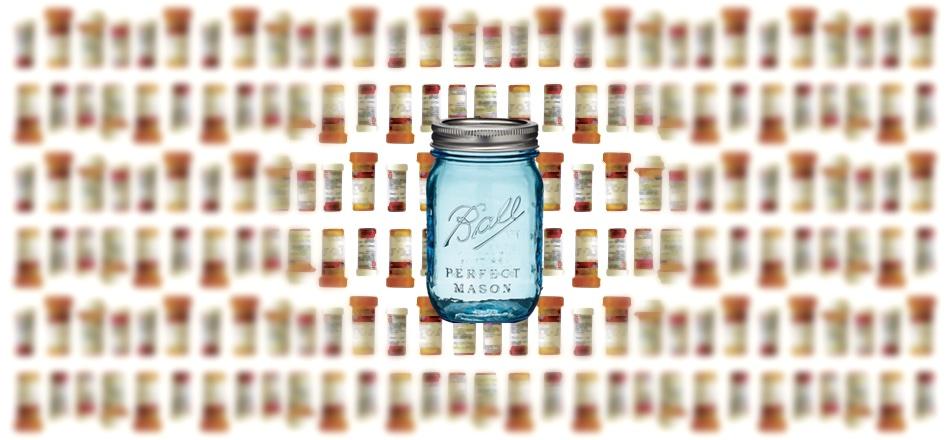Step 17- Gather the Gear

Why this step is important
Learn about the needed gear and how to obtain it.
Getting oriented
It may be helpful to do a full read-through of both the ‘Gear Checklist’ for your chosen taper method below and the skills for your particular gear in Step 18 before setting out to obtain equipment, since your preferences may become clearer after you have a strong sense of exactly how you’ll be using your gear.
Gear for making a liquid mixture using immediate-release tablets or capsules
- Graduated cylinders and pipettes (optional alternative to jars and slip tip syringes)
- Jars (required)
- Labels and pen/marker (if storing additional doses)
- Mortar and pestle (if crushing a tablet)
- Refrigerator and/or cooler bag (when refrigeration of drug is required)
- Slip tip, non-needle syringes (required)
Click here to go to Step 18 and review the skills that are essential to learn for working with this gear.
Gear for using a digital scale to weigh a crushed, immediate-release tablet or the contents of a capsule
- Digital scale (required)
- Empty capsules (required)
- Label and pen/marker (if storing additional doses or extra beads from a beaded capsule)
- Measuring bowl or tray (required)
- Mortar and pestle (if crushing tablets)
- Pharmaceutical-grade powder filler (if wishing to increase base weight of powdered drug)
- Pill bottles (if storing additional doses)
- Pill organizer (if organizing daily/weekly doses)
- Transferring implement(s) such as scoop, spoon, micro-spatula, or mini-funnel (required)
Click here to go to Step 18 and review the skills that are essential to learn for working with this gear.
Gear for using a compounding pharmacy to obtain capsules and/or liquid
- Adapter caps (if using compounded liquid)
- Pill organizer (if organizing daily/weekly doses)
- Refrigerator and/or cooler bag (when refrigeration of drug is required)
- Slip tip, non-needle syringes (if using compounded liquid)
Click here to go to Step 18 and review the skills that are essential to learn for working with this gear.
Gear for counting beads from a beaded capsule
- Bead-counting surface (required)
- Counting implement (required)
- Empty capsules (required)
- Labels and pen/marker (if storing additional beads)
- Pill bottles (if storing additional doses)
- Pill organizer (if organizing daily/weekly doses)
- Transferring implement(s) such as scoop, spoon, micro-spatula, or mini-funnel (required)
Click here to go to Step 18 and review the skills that are essential to learn for working with this gear.
Gear for using a manufacturer’s oral liquid
- Adapter caps (required)
- Jars (if diluting)
- Refrigerator and/or cooler bag (when refrigeration of drug is required)
- Slip tip, non-needle syringes (required)
Click here to go to Step 18 and review the skills that are essential to learn for working with this gear.
For explanations, further details, and tips from the layperson withdrawal community, click on any of these items in your chosen method's gear list above, or in our A to Z Gear List in the sidebar menu.
In this section
- Step 10- Get Informed About Your Psychiatric Drug
- Step 11- Ensuring that a Drug is Relatively ‘Taper-friendly’
- Step 12- Interactions, Reactions and Sensitivities
- Step 13- Taper Rates
- Step 14- Taper Schedules
- Step 15- Taper Methods
- Step 16- Preparatory Decisions
-
Step 17- Gather the Gear
- Adapter Caps
- Bead-counting Surface
- Counting Implement
- Digital Scale
- Empty Capsules
- Graduated Cylinders and Pipettes
- Jars
- Labels and Pen/marker
- Measuring Bowl or Tray
- Mortar and Pestle
- Pharmaceutical-grade Powder Filler
- Pill Bottles
- Pill Organizer
- Refrigerator and/or Cooler Bag
- Slip Tip Syringes
- Transferring Implements
- Step 18- Essential Skills
- Step 19- Setting Up a Taper Journal
- Step 20- Implementing a Taper
TWP’s Companion Guide to Psychiatric Drug Withdrawal Part 2: Taper